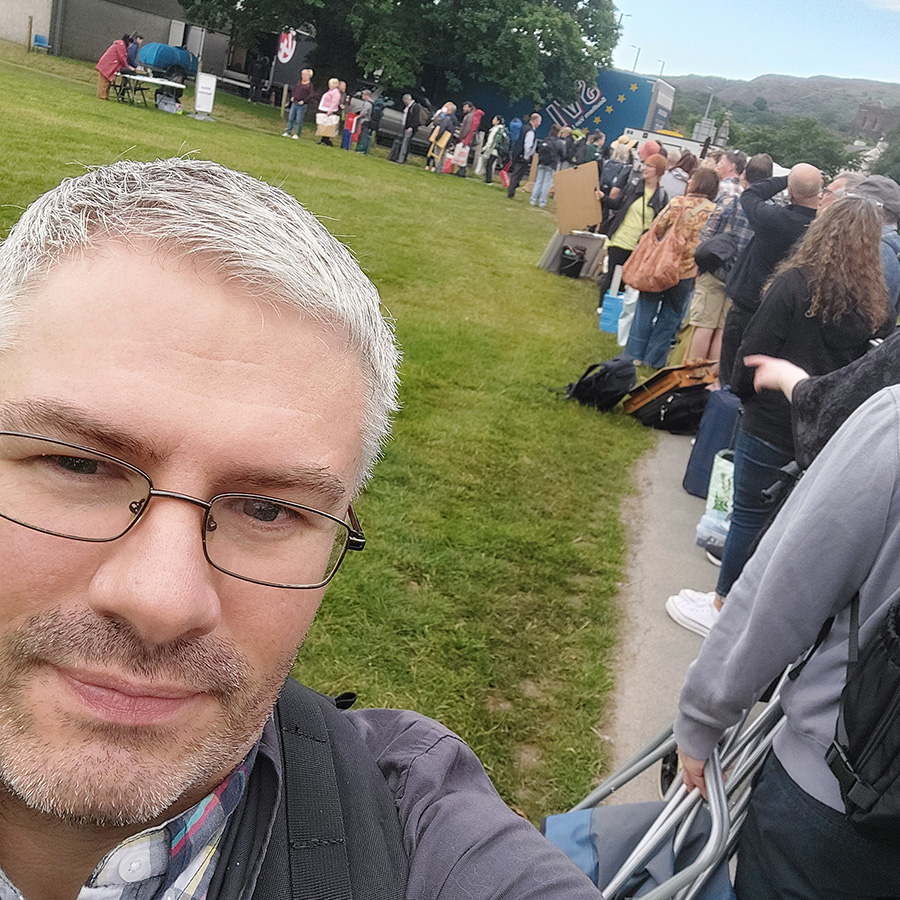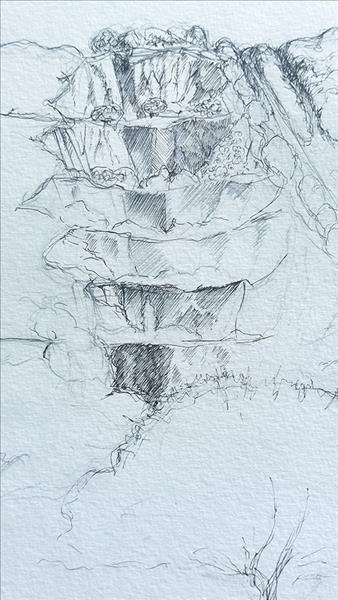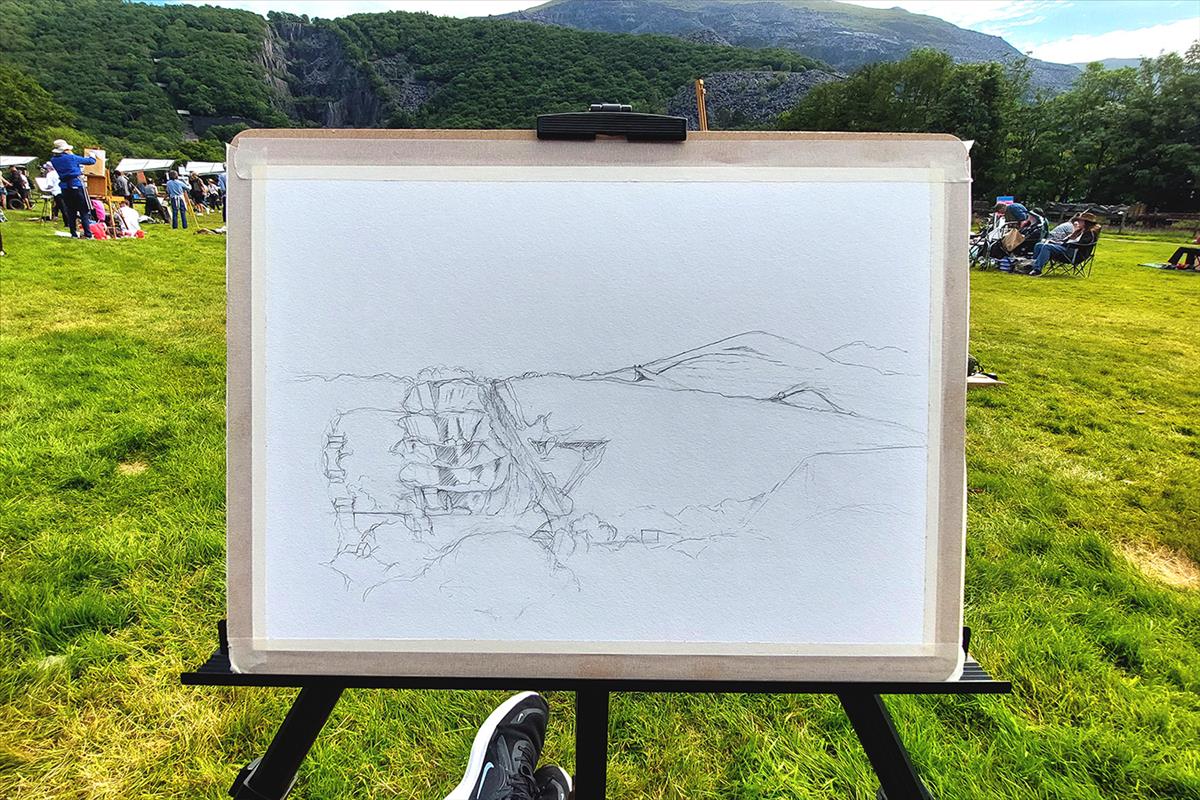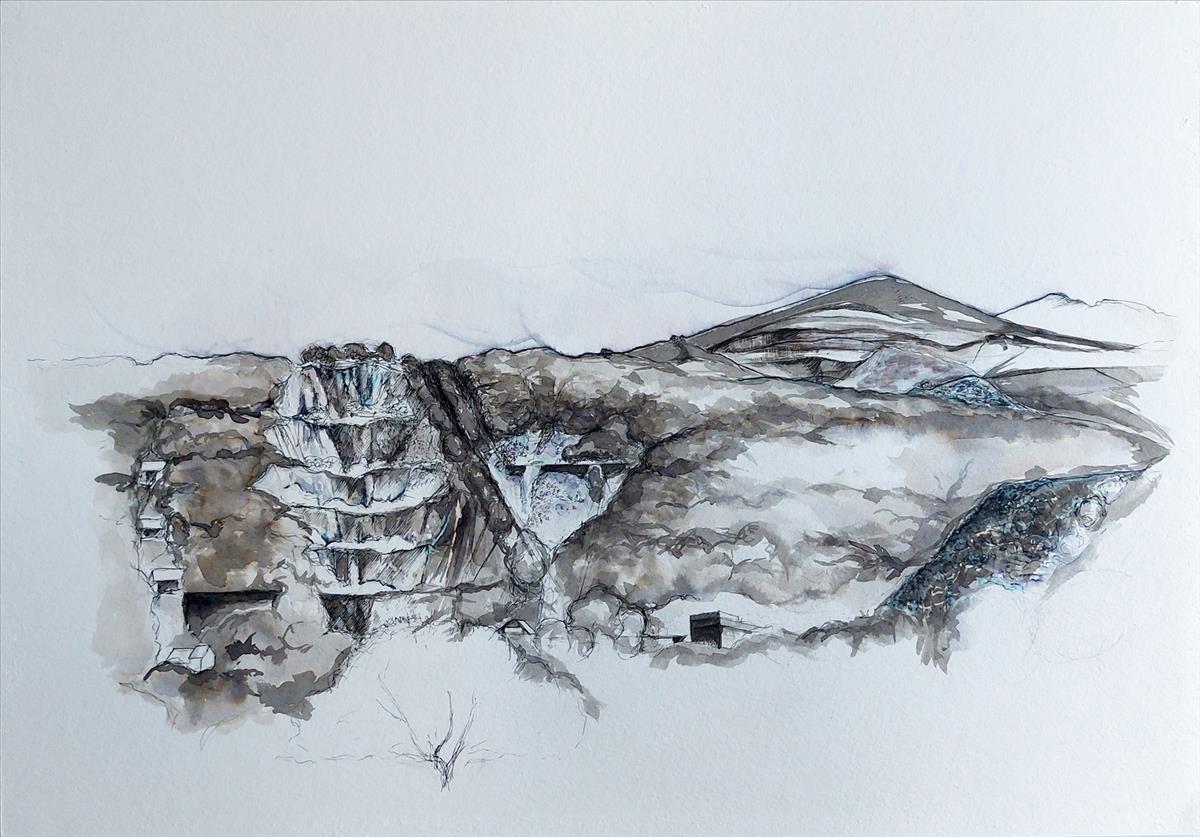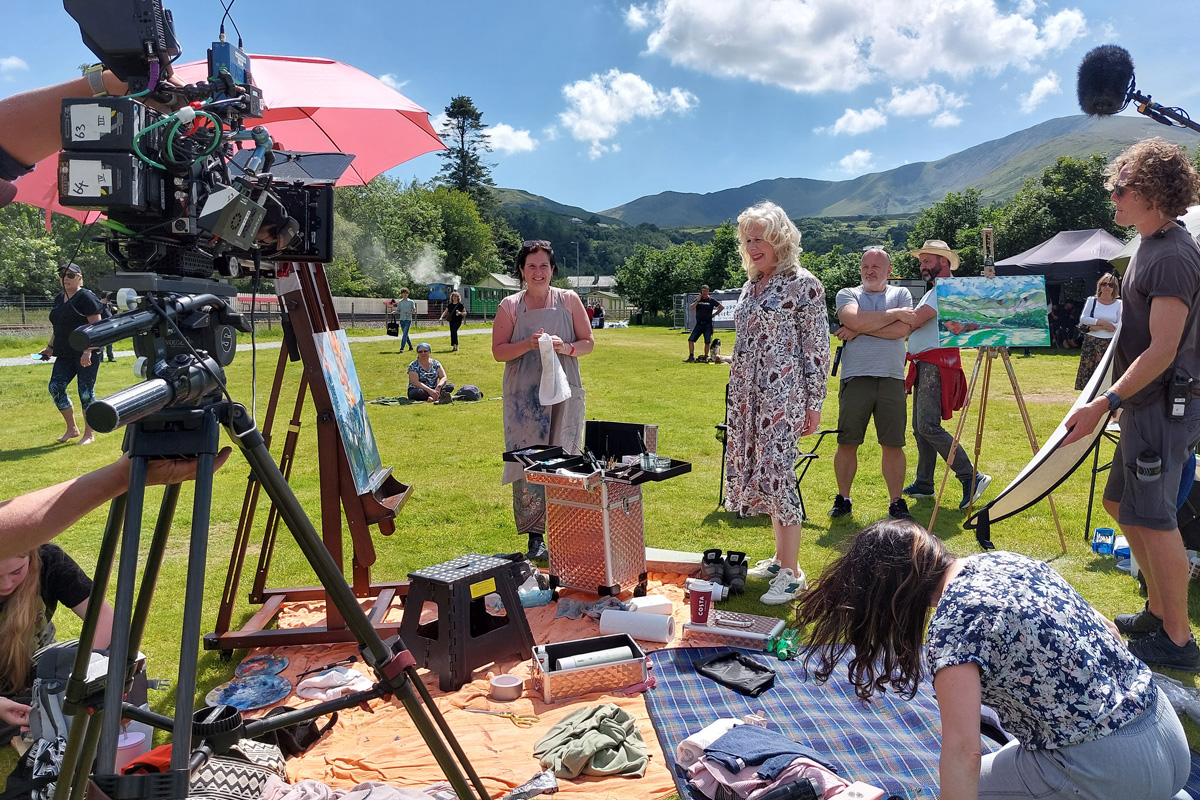The Day of the Competition
I woke early on the morning of the competition, arriving at the registration point by 7:20 AM. Everyone there was just as prepared as I was, their kits neatly packed into trolleys. I couldn’t help but feel sorry for those lugging wooden easels. They looked so cumbersome, but they certainly weren’t alone. Plenty of participants had brought them despite the challenge of carrying them.
The morning air was cool, and the grass glistened with dew. A lingering warmth remained from the previous day, the hottest of the year at 23°C, and today promised to be just as warm. The scene we were set to draw lay just beyond the field behind the Community Centre where we registered. At first, with the sun rising behind it, the landscape appeared as a stark silhouette, offering little detail. It seemed impossible to capture anything of interest. But as the sun climbed higher, its light gradually revealed the contours of the land.
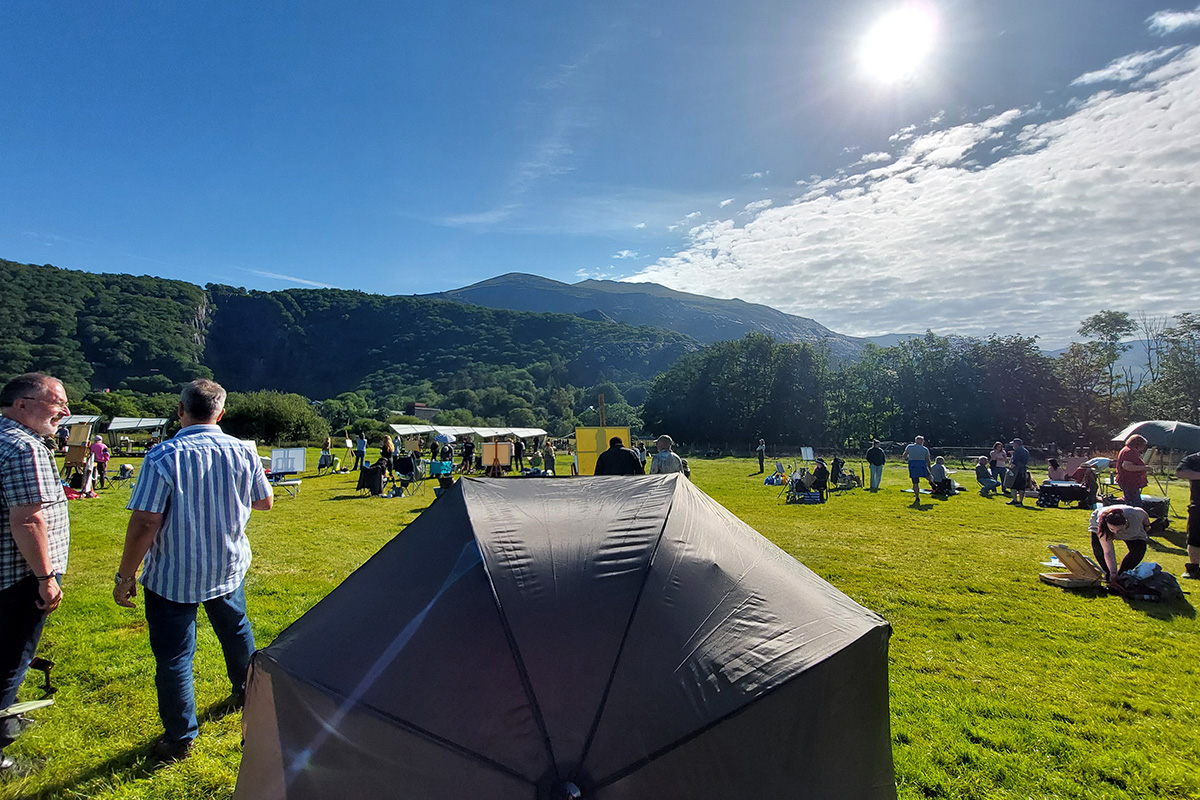
The Dinorwic Victoria slate quarry of Llanberis emerged from the shadows, accompanied by vast heaps of discarded slate from the neighboring quarries. I quickly realized this view was not about color but texture. The densely wooded hillside, resembling a crate of broccoli florets, stood in stark contrast to the jagged, man-made scars of excavation beneath it. The scene was raw, industrial, and undeniably striking. It was clear why this location had been chosen.
After setting up my kit, I began with a quick sketch in my sketchbook to test whether my chosen composition would work within a standard page ratio. I decided on a full vista of the hillside, placing the quarry to the left and the beginning of the slag heaps and distant mountain peaks to the right. The hillside occupied the lower three-fifths of the page, leaving space for the sky and mountains above to provide a sense of scale.
First Half
In my initial pencil sketch, I focused on plotting out the main components of the landscape, carefully establishing the shapes and structure I saw before me. I knew the shifting light would be unpredictable, so I avoided committing too early to specific lighting details. Instead, I concentrated on capturing the essence of the scene, the rugged textures within the quarry’s scar, the slate slag heaps to the right, and the organic, irregular outlines of the trees surrounding the dominant forms.
When I looked up, I noticed that many of the other artists were already deep into applying color and texture, while I was still refining the foundations of my composition. Just as doubt began to creep in, Tai Shan Schierenberg, one of the judges, unexpectedly peeked over my shoulder. “Ooooh, strong start!” he remarked, much to my surprise. His words bolstered my confidence. Now my only real challenge was making sure I didn’t spill ink all over it!
Later, Stephen popped his head over my easel and, with genuine enthusiasm, said, “Oh, that’s really nice!” I chuckled and replied, “I’m not so sure ‘nice’ is what I was going for.” Without missing a beat, he shot back, “Well, in that case, it’s rubbish.” With a big grin from him and a laugh from me, he toddled off to tease the next unsuspecting wildcard.
Second Half
Back to the image, the trees worried me the most. They dominated the scene, and I struggled with how to represent them effectively. I experimented with using ink washes sponged with sterilising fluid to create rough textures, but it didn't work. Thankfully, I tested it separately rather than on the actual drawing, or I would have had to start over. Art is all about learning to see and discovering new ways to approach the challenges of representation. Instead of further experimentation, I decided to treat the trees the way I approach clouds and hair. Layer by layer, selective ink washes built up their form until they resembled clouds of industrial smoke, which I was quite pleased with. In hindsight, I might have brought some salt or sugar to help create texture for the foliage.
Later on, Kathleen Soriano, another of the judges, stopped by for a chat. She said she really liked what I had done and thought the choice of monochrome was particularly strong. My mum had noticed that no other artist was working in monochrome. Many had taken creative liberties, adding lilacs, pinks, and purples that didn’t really exist in the scene—at least, not that I could see. The result made the landscape appear much prettier than it really was. Dramatic, yes. Pretty, not so much. Monochrome is the approach I am most comfortable with. People have occasionally told me that I “see the world too black and white,” which I suppose I take quite literally. I like how working in monochrome allows me to cut through the distraction of colour and focus purely on light and dark. My only guilt is in creating contrast where perhaps none exists, simply to help bring out distinction.
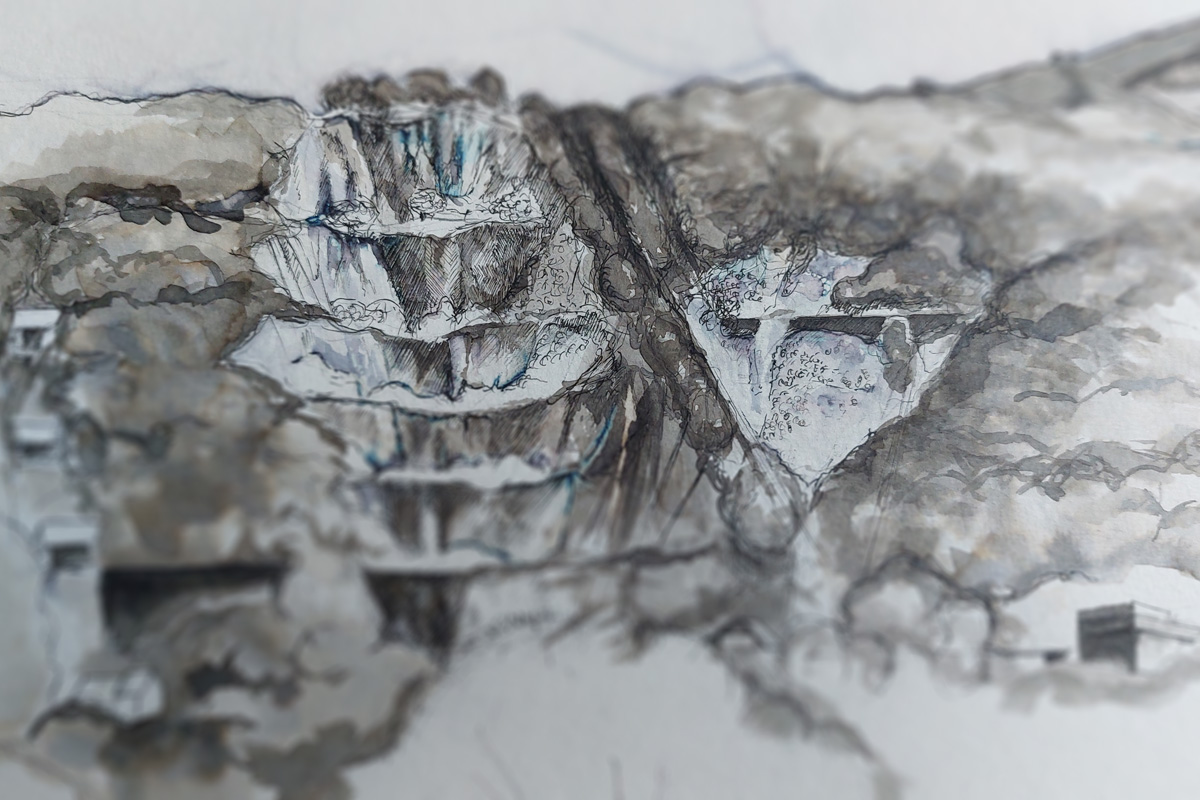
With half an hour to go, I decided I was done. I had no desire to continue, as I felt I had achieved everything I could within the three and a half hours I had spent on it. Satisfied with my work, I took the opportunity to walk around, chat with other artists, and watch as the judges spoke with contestants in front of the cameras.
A worthy wildcard contestant was selected to move on to the next heat, and filming wrapped up for the main contestants in the pods. I had a particular favorite, though sadly, I didn’t get to stay and find out how far they made it. Like everyone else, I’ll have to wait and see when the episode airs.
Since my birthday was the next day, after packing up, my parents and I went out for a lovely evening meal at Dylan’s near Menai Bridge to celebrate. It was the perfect way to end a thoroughly enjoyable day drawing in the sunny valleys of North Wales.
Conclussion
After everything I experienced, I wish I had taken part in this years ago. I have spoken to friends from my local Urban Sketchers and life drawing groups, encouraging them to join in. It is a truly positive experience and a fantastic excuse to get outside and create art in beautiful and often functional British landscapes.
Nobody should deny themselves the chance to enjoy something so rewarding. Do not focus on the competition or question whether you are "good enough." You are good enough. Just go out there and do it.
